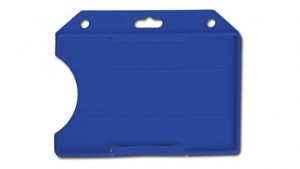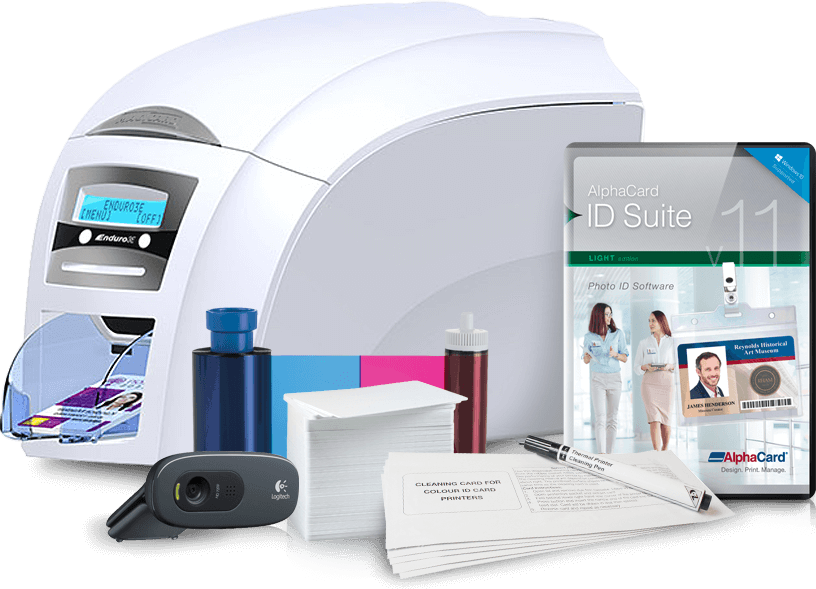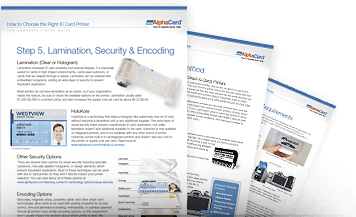Inkjet Card Printers
Inkjet Card Printers

Inkjet Card Printers
 ID Card Maker
ID Card Maker
Inkjet Card Printers
Printing Process Dye Sublimation and Thermal Transfer
Most plastic card printers feature the same basic printing operations - dye sublimation and/or thermal transfer printing. Both techniques involve a ribbon being heated as it passes under a thermal print head. The difference is that thermal transfer ribbons heat up and transfer ink onto the plastic card, and dye sublimation ribbons heat up and undergo a chemical change process that turns the ink into a gaseous state which then permeates the plastic card.
The ribbon used in color dye sublimation printing is divided into three separate color panels: yellow, magenta and cyan. This configuration is referred to as YMC.
These three colors are the primary colors used in printing to produce all other colors including black.
The dye from the ribbon is applied to the plastic card via a multi-pass operation. This means the card will pass under the print head once for each of the three colored ribbon panels, applying each color separately.
Plastic Card Printers
The term dye sublimation also is referred to as dye diffusion. When the dye on the ribbon is heated by the print head it is transformed from a solid to a gas and diffused onto the plastic card (the card is specially coated to absorb the color dye). The hotter the elements in the print head, the more dye is converted to a gas and absorbed into the plastic card. At 300 dpi the picture quality and continuous color tones produced by a dye sublimation printer outperform most laser or ink jet printers with higher resolutions.
The advantage of dye sublimation is the millions of colors that can be created. The colors result from a combination of the panels on the ribbon. By combining these colors and varying the intensity of the heat, providing various shades of each color, you are virtually unlimited in your color selection.
Thermal transfer differs from dye sublimation in that thermal transfer uses ink rather than dye. Both dye sublimation and thermal ink (sometimes refered to as resin) can be combined in one ribbon (see Figure 2). This ribbon is referred to as a YMCK ribbon. The letter "K" is the designator for the color black in the printing industry.
Why do you need a separate black panel, when you can create black by mixing the three basic YMC colors together?
The answer to this question is simple. When black is created by mixing the YMC colors together it creates what is referred to as "composite black." Composite black typically looks muddy or has a grayish tint when compared to thermal transfer (TT or resin) black. Composite black is not recommended for printing bar codes since combining the three colors together does not produce the sharp edge many scanners require (this is invisible to the naked eye but can be observed under magnification). Composite black also is invisible to IR scanners because there is no carbon in the dye. Since you may not know what type of scanner will be used, the rule is to always use TT (resin) black to print bar codes.
All color printers are capable of printing in monochrome using a single color ribbon. These ribbons are less expensive than full-color multi-panel ribbons and can be either dye or ink (thermal transfer). The most commonly used monochrome ribbon is black, but there are several other colors available, including red, green and blue.
Monochrome
Dye sublimation ribbons are preferred when you are printing pictures, because they can produce many shades of gray for a smoother look and a better picture quality. A resin black picture normally uses a dithered gray scale (gray made from a combination of pixels which limits the number of shades), producing a coarser, grainy look to the image.
Thermal transfer (resin) ribbons should be used to print text, bar codes or single color graphics such as simple logos. Black monochrome ribbons are represented by the letter "K" followed by a lower case "r or d", (Kr or Kd). The "r" designates a thermal transfer ribbon with resin ink. The "d" designates a dye sublimation ribbon.
Reverse Transfer
This process prints images on the reverse side of a retransfer film. The film is then laminated to the face of a PVC card with heat and pressure. The process uses the same four color panels as a dye sublimation printer but produces much higher quality because the dye bleeds less on the film than it does on a PVC card. Also, since the film is laminated to the card it is virtually impossible to tamper with the card without destroying it.
Inkjet printing
Inkjet printing has been around for a long time and is common in today's office. However, it has just been introduced to ID card printing. Currently, only Fargo has inkjet printers and they require specially formulated ink and PVC cards to work.
There are three main steps to producing a drop with thermal technology. First, the chamber holding the ink bubble is heated. Second, the bubble bursts due to heat and the ink drop shoots out of the nozzle. Finally, the vacuum from the drop leaving the chamber draws the next bubble into the chamber. There are between 300 and 600 nozzles per print head, all of which can fire at the same time. "These deliver drop volumes of around 8 - 10 [picoliters] (a [picoliter] is a million millionth of a [liter]), and dot sizes of between 50 and 60 microns in diameter." Thirty microns is the smallest dot size visible to the naked eye.
There are 300 to 600 of these firing mechanisms per print head. Four to eight of these tiny drops are fired onto the paper to make a color dot. Larger dots of 35 picoliters are usually created with black inks. Part of this difference is that the colors are usually created with dye-based ink and the black ink is a pigment-based ink. Dye-based inks produce a wide range of vibrant colors whereas pigment-based inks are more durable and water-resistant. Pigment-based inks also have larger molecules because they are particles suspended in solution. Because thermal technology uses heat to create the drop, all the inks used must be heat resistant. This narrows the selection of inks and their characteristics such as water-resistance.
-

Horizontal Semi Rigid Card Holder w/ Selectable Color - 50 Pack
MSRP: $34Price: $23.98You Save: $10.02 (29%)
Not sure how to choose
an ID card printer?


The Complete Card
Printer Buyer's Guide
With such a wide range of ID printers, evaluating the options can be overwhelming. This FREE 7-step guide will walk you through choosing the perfect card printer.
GET YOUR FREE GUIDE

